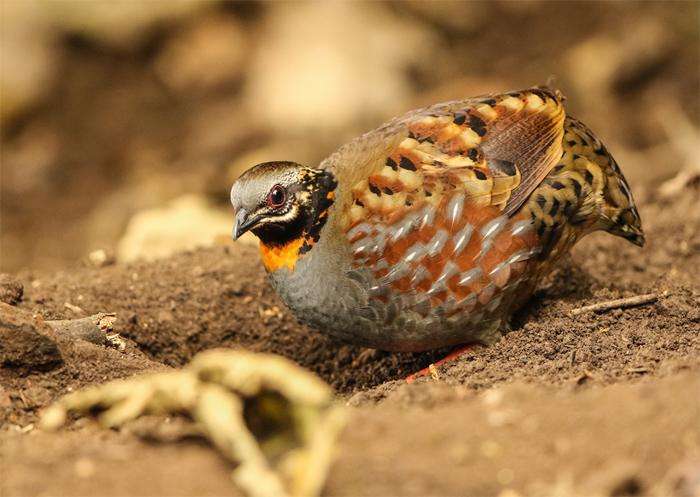Arborophila mandellii
IUCN
LCBasic Information
Scientific classification
- name:Arborophila mandellii
- Scientific Name:Arborophila mandellii
- Outline:Landfowl
- Family:Galliformes Phasianidae Partridge
Vital signs
- length:24.3-28cm
- Weight:253-320g
- lifetime:No verification information
Feature
The upper chest is chestnut, the lower chest to the anus is gray, and the ribs have chestnut and white spots
Distribution and Habitat
The Red-breasted Mountain Quail is found in Sikkim, Bhutan and India, but in China it is only found in the Danba River and Mishmi Mountain near Medog in southeastern Tibet.
The Red-breasted Mountain Quail mainly lives in dense evergreen forests at an altitude of 1,200-2,500 meters, especially in evergreen forest belts with lush understory plants.
Appearance
The red-breasted mountain partridge has dark chestnut color in front of the eye, forehead, top of the head and nape, which gradually changes to brown at the back of the neck. There is a narrow light yellow stripe below the front of the eye; the eyebrow is dark gray, extending from the front of the eye to the back and meeting the dark gray eyebrow on the left and right of the back of the neck. The lower part of the back of the neck and the upper back are light red chestnut with black spots. The sides of the neck are brown with black spots. The feathers from the lower back to the underside of the tail are olive with narrow black feather edges; except for the back, the rest of the feathers have a wide central black spot; the shoulders and upper wing coverts are the same color as the back, but with finer black spots; the wings are brown, and the inner secondary flight feathers and large coverts have chestnut feather edges, light gray spots and wide black terminal spots. The chin and throat
Details
The Red-breasted Partridge is called Collared Partridge in English. It has no subspecies and is a medium-sized nearly gray partridge. It is an extremely rare resident bird in China.

Red-breasted Partridge often lives and moves in small groups, mostly near streams. It is extremely timid, often hiding under the forest, in the bushes or in the grass, and rarely takes off. It often moves and runs in the bushes and grass under the forest. When frightened, it usually runs a short distance, then crouches under the bushes and other cover, or flies a few meters away and hides in the tall grass. It only takes off suddenly when it is in a very dangerous situation. It often sings when it is active. The male bird is extremely noisy in spring, often flying to the alder roost to sing. The call is loud, full, long notes followed by a series of ascending double notes until the climax. The sound is similar to that of the Red-throated Mountain Quail.
When foraging, the Red-breasted Mountain Quail often wanders in pairs or small groups, digging through the leaf litter on the ground in the bushes to find insects and seeds for food. It mainly feeds on insects such as beetles and termites, small invertebrates, and plant seeds. Often forages in the fallen leaves on the ground under the forest. Rests or drinks water at the stream when it is hot at noon.
The breeding season of the Red-breasted Mountain Quail is from April to June. It nests on the ground under the forest in mountain forests between 1500-4000 meters above sea level, using natural pits on the ground or a small pit dug by the female bird. The nest is often covered by lush bushes or understory plants and is not easy to find, but sometimes it also nests in places where the understory plants are sparse and not very hidden. The Red-breasted Mountain Quail lays 3-6 eggs per nest, and the size of the eggs is 44×34.4 mm. The incubation period is 20-21 days.
Although the Red-breasted Mountain Quail has a wide distribution range, it occurs at a low density and is distributed in blocks. Moderately small in number, and likely to decline rapidly and continuously within its distribution range, so it is listed as near threatened.
Listed in the "National List of Terrestrial Wildlife with Important Economic and Scientific Research Value" (Item 88) issued by the State Forestry Administration on August 1, 2000.
Listed in the "Red List of Endangered Species of the World Conservation Union" (IUCN) 2016 ver 3.1-Vulnerable (VU).
Listed in the second level of China's "National Key Protected Wildlife List" (February 5, 2021).
Protect wild animals and stop eating game.
Maintaining ecological balance is everyone's responsibility!








